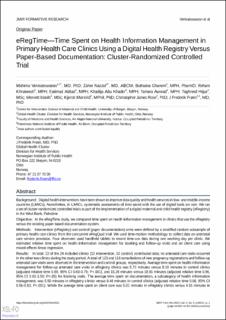| dc.contributor.author | Venkateswaran, Mahima | |
| dc.contributor.author | Nazzal, Zaher | |
| dc.contributor.author | Ghanem, Buthaina | |
| dc.contributor.author | Khraiwesh, Reham | |
| dc.contributor.author | Abbas, Eatimad | |
| dc.contributor.author | Khader, Khadija Abu | |
| dc.contributor.author | Awwad, Tamara | |
| dc.contributor.author | Hijaz, Taghreed | |
| dc.contributor.author | Isbeih, Mervett | |
| dc.contributor.author | Blom-Bakke, Kjersti Mørkrid | |
| dc.contributor.author | Rose, Christopher James | |
| dc.contributor.author | Frøen, Jahn Frederik Alexander Claude | |
| dc.date.accessioned | 2022-12-28T12:21:06Z | |
| dc.date.available | 2022-12-28T12:21:06Z | |
| dc.date.created | 2022-05-13T16:33:38Z | |
| dc.date.issued | 2022 | |
| dc.identifier.issn | 2561-326X | |
| dc.identifier.uri | https://hdl.handle.net/11250/3039645 | |
| dc.description.abstract | Background:
Digital health interventions have been shown to improve data quality and health services in low- and middle-income countries (LMICs). Nonetheless, in LMICs, systematic assessments of time saved with the use of digital tools are rare. We ran a set of cluster-randomized controlled trials as part of the implementation of a digital maternal and child health registry (eRegistry) in the West Bank, Palestine.
Objective:
In the eRegTime study, we compared time spent on health information management in clinics that use the eRegistry versus the existing paper-based documentation system.
Methods:
Intervention (eRegistry) and control (paper documentation) arms were defined by a stratified random subsample of primary health care clinics from the concurrent eRegQual trial. We used time-motion methodology to collect data on antenatal care service provision. Four observers used handheld tablets to record time-use data during one working day per clinic. We estimated relative time spent on health information management for booking and follow-up visits and on client care using mixed-effects linear regression.
Results:
In total, 22 of the 24 included clinics (12 intervention, 10 control) contributed data; no antenatal care visits occurred in the other two clinics during the study period. A total of 123 and 118 consultations of new pregnancy registrations and follow-up antenatal care visits were observed in the intervention and control groups, respectively. Average time spent on health information management for follow-up antenatal care visits in eRegistry clinics was 5.72 minutes versus 8.10 minutes in control clinics (adjusted relative time 0.69, 95% CI 0.60-0.79; P<.001), and 15.26 minutes versus 18.91 minutes (adjusted relative time 0.96, 95% CI 0.61-1.50; P=.85) for booking visits. The average time spent on documentation, a subcategory of health information management, was 5.50 minutes in eRegistry clinics versus 8.48 minutes in control clinics (adjusted relative time 0.68, 95% CI 0.56-0.83; P<.001). While the average time spent on client care was 5.01 minutes in eRegistry clinics versus 4.91 minutes in control clinics, some uncertainty remains, and the CI was consistent with eRegistry clinics using less, the same, or more time on client care compared to those that use paper (adjusted relative time 0.85, 95% CI 0.64-1.13; P=.27).
Conclusions:
The eRegistry captures digital data at point of care during client consultations and generates automated routine reports based on the clinical data entered. Markedly less time (plausibly a saving of at least 18%) was spent on health information management in eRegistry clinics compared to those that use paper-based documentation. This is likely explained by the fact that the eRegistry requires lesser repetitive documentation work than paper-based systems. Adoption of eRegistry-like systems in comparable settings may save valuable and scarce health care resources. | en_US |
| dc.language.iso | eng | en_US |
| dc.publisher | JMIR | en_US |
| dc.rights | Navngivelse 4.0 Internasjonal | * |
| dc.rights.uri | http://creativecommons.org/licenses/by/4.0/deed.no | * |
| dc.title | eRegTime—Time Spent on Health Information Management in Primary Health Care Clinics Using a Digital Health Registry Versus Paper-Based Documentation: Cluster-Randomized Controlled Trial | en_US |
| dc.type | Journal article | en_US |
| dc.type | Peer reviewed | en_US |
| dc.description.version | publishedVersion | en_US |
| dc.rights.holder | Copyright 2022 The Author(s) | en_US |
| dc.source.articlenumber | e34021 | en_US |
| cristin.ispublished | true | |
| cristin.fulltext | original | |
| cristin.qualitycode | 1 | |
| dc.identifier.doi | 10.2196/34021 | |
| dc.identifier.cristin | 2024505 | |
| dc.source.journal | JMIR Formative Research | en_US |
| dc.relation.project | ERC-European Research Council: 617639 | en_US |
| dc.relation.project | Norges forskningsråd: 234376 | en_US |
| dc.relation.project | Universitetet i Bergen: 223269 | en_US |
| dc.identifier.citation | JMIR Formative Research. 2022, 6 (5), e34021. | en_US |
| dc.source.volume | 6 | en_US |
| dc.source.issue | 5 | en_US |

